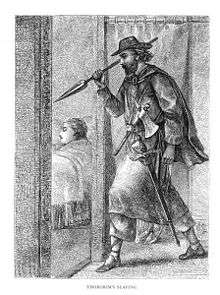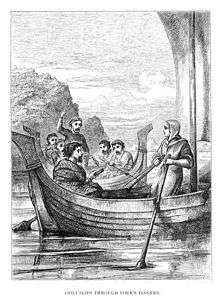Gísla saga

Gísla saga Súrssonar (Icelandic pronunciation: [ˈcisl̥a ˈsaːɣa ˈsur̥sɔnar̥], the saga of Gísli Súrsson) is one of the Sagas of Icelanders. It tells the story of Gisli, a tragic hero who must kill one of his brothers-in-law to avenge another brother-in-law. Gisli is outlawed and forced to stay on the run for thirteen years before he is finally hunted down and killed. The events depicted in the saga take place between 860 A.D. and 980 A.D. The saga existed in oral tradition until it was recorded, most likely in the 13th century .In 1981 it was made into a film titled Útlaginn (The Outlaw).
Manuscripts and dating
Gísla saga survives in thirty-three manuscripts and fragments from the Middle Ages down to the twentieth century. It is generally thought to have been composed in written form in the first half of the thirteenth century, but the earliest manuscript, the fragment Reykjavík, Stofnun Árna Magnússonar, AM 445 c I 4to, is from around 1400 and the earliest extensive text in AM 556a 4to, from the later fifteenth. The saga is generally thought to exist in three main versions originating in the Middle Ages:[1]
- the 'fragmentary version' (attested by AM 445 c I 4to, often known in scholarship as version 'B' for 'brot' ['fragment'])
- the 'shorter version' (attested primarily in AM 556a 4to, Eggertsbók, often referred to in scholarship as 'E' for 'eldri' ['earlier'] or 'M' for 'mindre' ['shorter'], and from which most other manuscripts seem to be descended)
- the 'longer version' (attested primarily in two eighteenth-century scholarly transcripts of a lost medieval manuscript known as the 'Membrana regia deperdita': AM 149 fol and Copenhagen, Det kongelige bibliotek, NKS 1181 fol. This version is often referred to as 'Y' for 'yngri' ['later'] or 'S' for 'større' ['longer']. Only two other manuscripts contain this version.).[2]
The longer version differs from the shorter mainly in having a profoundly different (and longer) version of the opening sequence of the saga's narrative, set in Norway. The parts set in Iceland are substantially similar.[3]
There is a consensus that the written archetype of Gísla saga was composed in the thirteenth century, with voices tending towards the middle of the century, and most commentators preferring 1225×50. However, there is little hard evidence to support this.[4]
Themes
Gísla saga is a classic outlaw saga that is centered on the internal struggles of Gísli. As Gisli's fate unfolds, he experiences conflicting passions of love, hate, and complex emotional bonds. Differing from the typical family saga, it uses the common theme of vengeance to divide loyalties within family instead of strengthening familial bonds. More than most sagas, Gísla saga makes use of motifs from the Eddaic poems, in particular by referring to Guðrún Gjúkadóttir to represent old ways of vengeance and family honor.[5]
Synopsis

Around 950 Gísli Súrsson and his family decide to leave Norway and move to Iceland. The two brothers, Gisli and Thorkel, and their brothers-in-law Vestein and Thorgrim, are joining together in a ceremony involving a spear, which will make the four blood brothers and signify their loyalty to one another. The ceremony is not completed because Thorgrim retracts his obligation to Vestein, which in turn causes Gisli to negate his bond with Thorgrim. From this moment on the characters’ actions seem to be controlled completely by fate as they head down a tragic path.
A chain of dreadful events is set into motion when Thorkel catches his wife, Asgerd, and Aud, Gisli's wife, gossiping about their loves. When Asgerd reveals that she loves Aud's brother Vestein more than her husband, Thorkel is infuriated and decides to move away from the farm that he and Gisli shared. Aud explains to Gisli what she and Asgerd were gossiping about and how Thorkel overheard their conversation. Thorkel and Asgerd move onto the nearby farm of Thorgrim. Upon his arrival, Thorkel joins with Thorgrim to discuss various things, perhaps even planning Vestein's murder. However, nothing is certain. Soon after Thorkel moves in with Thorgrim, Vestein comes to Gisli's farm to visit with the family. Gisli attempts to warn Vestein not to come because it is not safe for him. Unfortunately, Vestein is not warned in time and arrives at Gisli's farmhouse. Soon after, he is murdered one night while sleeping at Gisli's house. Gisli rushes into the house and grabs the spear out of Vestein’s chest, signifying that he will take vengeance for Vestein's murder. Although the identity of the intruder is never revealed, Gisli is haunted by dreams which convince him that Thorgrim is the murderer. In these dreams there are two women, symbolizing good and evil and representing the choice Gisli must eventually make.

In order to avenge the death of Vestein, a man to whom he is bound, Gisli murders Thorgrim and escapes into the night without being discovered. However, Thordis, Gisli’s widowed sister, suspects that Gisli must have murdered her husband, and tells her new husband, Thorgrim's brother Bork. Bork is persuaded to pursue a lawsuit of outlawry, rather than attempt to kill Gisli at once. Once Gisli is outlawed he constantly runs from a group of men who wish to find and murder him, led by Bork. This task proves to be more difficult than perceived, as they are unable to locate Gisli in his various hiding places. While Gisli is on the run, Vestein's two sons decide to seek their own vengeance for their father's murder. The two boys murder Thorkel. Both Bork and Gisli wish to avenge the death, but others, relatives of Vestein such as Gisli's wife Aud, discourage it and nothing is done. Gisli says that it is just as well that he has not met nor will ever meet the lads. The lads' fates are mentioned on the last page of the saga.

Aud, Gisli’s wife, remains loyal throughout the saga and refuses to divulge the location of her husband, even when Eyjolf offers her three hundred silver pieces, help in remarriage and reminds her of her current hard life at Geirthjofsfjordhur. Gisli's dreams continue to plague him, and eventually he is not able to run from his problems or the people who are hunting him. After Gisli is discovered, Aud and their foster-daughter Gudrid fight side-by-side with Gisli until he is killed in a final, strenuous battle. Even after Gisli is dead, he is still honoured and respected for being a loyal and honest man. The saga notes that his final blow was just as strong as his first. Once Gisli faces his death, Thordis experiences remorse for his murder and stabs Eyjolf in the leg. After Bork wrenches the sword out of her hand and attempts to calm the group, Thordis declares herself divorced from Bork and leaves the house. Aud and five others leave Iceland. Aud converts to the Christian faith and with Gunhillda the widow of Vestein takes a pilgrimage to Rome, never to return to Iceland.
Notes
- ↑ Emily Lethbridge, ' Gísla saga Súrssonar: Textual Variation, Editorial Constructions, and Critical Interpretations', in Creating the Medieval Saga: Versions, Variability, and Editorial Interpretations in Old Norse Saga Literature, ed. by Judy Quinn and Emily Lethbridge (Odense: University Press of Southern Denmark, 2010), pp. 123--52 (pp. 127--28); Þórður Ingi Guðjónsson, 'Editing the Three Versions of Gísla saga Súrssonar ', in Creating the Medieval Saga: Versions, Variability, and Editorial Interpretations in Old Norse Saga Literature, ed. by Judy Quinn and Emily Lethbridge (Odense: University Press of Southern Denmark, 2010), pp. 105--21.
- ↑ Cf. Agnete Loth, ed., Membrana regia deperdita, Editiones Arnamagnæanæ, A 5 (Copenhagen: Munksgaard, 1960).
- ↑ Þórður Ingi Guðjónsson, 'Editing the Three Versions of Gísla saga Súrssonar ', in Creating the Medieval Saga: Versions, Variability, and Editorial Interpretations in Old Norse Saga Literature, ed. by Judy Quinn and Emily Lethbridge (Odense: University Press of Southern Denmark, 2010), pp. 105--21 (p. 108).
- ↑ Emily Lethbridge, 'Dating the Sagas and Gísla saga Súrssonar ', in Dating the Sagas: Reviews and Revisions, ed. by Else Mundal (Copenhagen: Museum Tusculanum Press, 2013), pp. 77-113 (p. 83).
- ↑ Clark 2007:492 and passim.
References
- Clark, David. "Revisiting Gísla saga: Sexual Themes and the Heroic Past". JEGP 106 (2007):492-515.
- Johnston, George., trans. The Saga of Gisli Notes and introductory essay by Peter Foote. 1973. ISBN 0-8020-6219-9
- Regal, Martin S., trans. "Gisli Sursson's Saga." The Sagas of the Icelanders. New York: Penguin Books, 2000, pp. 496–557.
- Regal, Martin S. and Judy Quinn, trans. (ed. and introduced by Vésteinn Ólason). "Gisli Sursson's Saga and the Saga of the People of Eyrland." New York & London: Penguin, 2004. ISBN 0140447725. 320 pages.
External links
- Gisli the Outlaw English translation of Gísli Saga by George Webbe Dasent
- Full text and English translation at the Icelandic Saga Database
- Gísla saga Súrssonar Text with normalized Icelandic spelling
- Proverbs in Gísla saga
Coordinates: 65°52′37″N 23°38′09″W / 65.876829°N 23.635798°W